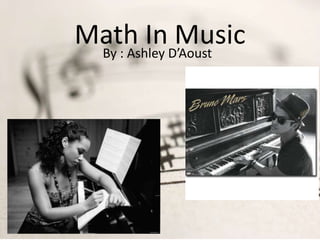
Music hol powerpoint q3
- 1. Math InD’Aoust By : Ashley Music
- 2. • Do you wonder why some notes played together sound so good? • The answer to that is the wave pattern of a note. Created by a guitar, piano or any other instrument. • The number of times per second each wave hit our ear is called frequency, which is measured in Hertz. (Hz) • The more waves per second, the higher the pitch.
- 3. Here is how to understand why some note combinations sound better, first look at the wave patterns of 2 notes that sound good together. Let’s use middle C and the G just above it as an example.. If you can notice every 3rd wave of the G matches up with every 2nd wave of the C. (The G note is the Red Wave) and (C note is the Green Wave)
- 4. • But here in the second graphic of a C and an F# they don’t make such a great sound because there is no pattern. (The F# note is the Red Wave) and (C note is the Green Wave)
- 5. Now let’s look at a chord, to find out why it’s notes sound good together. Here are the frequencies of the notes in the C Major chord. C – 261.6 Hz E – 329.6 Hz G – 392.0 Hz • The ratio of E to C is about 5/4ths. This means that every 5th wave of the E matches up with every 4th wave of the C. The ratio of G to E is about 5/4ths as well. The ratio of G to C is about 3/2. Since every note’s frequency matches up well with every other note’s frequencies they all sound good together.
- 6. C Major • Here are the ratios of the notes in the C Major key in relation to C: (this only applies to C major which is most common) • For example, the D note. The ration means every 9th wave of the D, matches up with every 8th wave of the C. • C–1 • D – 9/8 • E – 5/4 • F – 4/3 • G – 3/2 • A – 5/3 • B – 17/9
- 7. • Hertz (number of vibrations a second) = 6.875 x 2 ^ ( ( 3 + MIDI_Pitch ) / 12 ) • The MIDI Pitch value is according to the MIDI standard, where middle C equals 60, and the C an octave below it equals 48. As an example, let’s figure the hertz for middle C: • H = 6.875 x 2 ^ ( ( 3 + 60 ) / 12 ) = 6.875 x 2 ^ 5.25 = 261.6255 • H = Hertz. • The next note up, C#, is: • Hertz = 6.875 x 2 ^ ( ( 3 + 61 ) / 12 ) = 277.1826 • The next note, D, is: • Hertz = 6.875 x 2 ^ ( ( 3 + 62 ) / 12 ) = 293.6648 • The jump between C and C# is 15.56 Hertz, the jump between C# and D is 16.48 Hertz. Although the Hertz jump is not equal between the notes, it is an equal jump in the exponent number and it sounds like an equal jump to our ears going up the scale. This gives a nice smooth transition going up the scale.
- 8. Mathematics in Music • Pappas, Theoni. The Joy of Mathematics: Discovering Mathematics All around You. San Carlos, CA: Wide World Pub./Tetra, 1989. Print. • Heimiller, Joseph. "Where Math Meets Music." Voice-to-note MIDI Music Editor: Music Masterworks Composing Software. May 2002. Web. 20 Mar. 2012. <http://www.musicmasterworks.com/WhereMathMeetsMusic.html>. • http://www.google.com/imgres?q=bruno+mars+playing+piano&um=1&hl=en&safe=ac tive&biw=1366&bih=622&tbm=isch&tbnid=eRQnHka0gzqahM:&imgrefurl=http://poste rchase.com/bruno-mars-poster-piano-playing-shade-hat- 1223.html&docid=E8YKmUUL2VSEAM&imgurl=http://www.posterchase.com/media/ca talog/product/cache/1/image/335x335/5e06319eda06f020e43594a9c230972d/b/r/br uno-mars-poster-piano-playing-shade-hat-1223.jpg&w=335&h=335&ei=hbdoT6- 9NdGcgQer3b2WCQ&zoom=1&iact=rc&dur=257&sig=100404283061072677558&page =1&tbnh=125&tbnw=125&start=0&ndsp=21&ved=1t:429,r:3,s:0&tx=38&ty=55